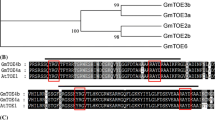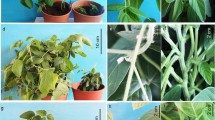Abstract
Soybean is a typical short-day crop, and its photoperiodic and gibberellin (GA) responses for the control of flowering are critical to seed yield. The GmGBP1 mRNA abundance in leaves was dramatically increased in short-days (SDs) compared to that in long-days in which it was consistently low at all time points from 0 to 6 days (days after transfer to SDs). GmGBP1 was highly expressed in leaves and exhibited a circadian rhythm in SDs. Ectopic overexpression of GmGBP1 in tobaccos caused photoperiod-insensitive early flowering by increasing NtCO mRNA levels. GmGBP1 mRNA abundance was also increased by GAs. Transgenic GmGBP1 overexpressing (-ox) tobacco plants exhibited increased GA signaling-related phenotypes including flowering and plant height promotion. Furthermore, the hypocotyl elongation, early-flowering and longer internode phenotypes were largely accelerated by GA3 application in the GmGBP1-ox tobacco seedlings. Being consistent, overexpression of GmGBP1 resulted in significantly enhanced GA signaling (evidenced suppressed expression of NtGA20ox) both with and without GA treatments. GmGBP1 was a positive regulator of both photoperiod and GA-mediated flowering responses. In addition, GmGBP1-ox tobaccos were hypersensitive to ABA, salt and osmotic stresses during seed germination. Heat-inducible GmGBP1 also enhanced thermotolerance in transgenic GmGBP1-ox tobaccos during seed germination and growth. GmGBP1 protein was localized in the nucleus. Analyses of a series of 5′-deletions of the GmGBP1 promoter suggested that several cis-acting elements, including P-BOX, TCA-motif and three HSE elements necessary to induce gene expression by GA, salicic acid and heat stress, were specifically localized in the GmGBP1 promoter region.










Similar content being viewed by others
References
Achard P, Herr A, Baulcombe DC, Harberd NP (2004) Modulation of floral development by a gibberellin-regulated micro-RNA. Development 131:3357–3365
Bechtold N, Pelletier G (1998) In planta Agrobacterium-mediated transformation of adult Arabidopsis thaliana plants by vacuum infiltration. Methods Mol Bio 82:259–266
Dellaporta SL, Wood J, Hicks JB (1983) A plant DNA miniprepration: version II. Plant Mol Biol Rep 1:19–21
Divi UK, Rahman T, Krishna P (2010) Brassinosteroid-mediated stress tolerance in Arabidopsis shows interactions with abscisic acid, ethylene and salicylic acid pathways. BMC Plant Biol 10:151
Doi K, Izawa T, Fuse T, Yamanouchi U, Kubo T, Shimatani Z, Yan M, Yoshimura A (2004) Ehd1, a B-type response regulator in rice, confers short-day promotion of flowering and controls FT-like gene expression independently of Hd1. Genes Dev 18:926–936
Frank G, Pressman E, Ophir R, Althan L, Shaked R, Freedman M, Shen S, Firon N (2009) Transcriptional profiling of maturing tomato (Solanum lycopersicum L.) microspores reveals the involvement of heat shock proteins, ROS scavengers, hormones, and sugars in the heat stress response. J Exp Bot 60:3891–3908
Gai J, Wang Y (2001) A study on the varietal eco-regions of soybeans in China. Sci Agric Sinica 34:139–145
Gocal GF, Sheldon CC, Gubler F et al (2001) GAMYB-like genes, flowering, and gibberellins signaling in Arabidopsis. Plant Physiol 127:1682–1693
Griffiths J, Murase K, Rieu I et al (2006) Genetic characterization and functional analysis of the GID1 gibberellin receptors in Arabidopsis. Plant Cell 18:3399–3414
Hadley P, Roberts EH, Summerfield RJ, Minchin FR (1984) Effects of temperature and photoperiod on flowering in soya bean [Glycine max (L.) Merrill]: a quantitative model. Ann Bot 53:669–681
Horsch RB, Fraley RT, Rogers SG, Sanders PR, Lloyd A (1985) A simple and general method for transferring genes into plants. Science 227:1229–1231
Hou X, Xie K, Yao J, Qi Z, Xiong L (2009) A homolog of human ski-interacting protein in rice positively regulates cell viability and stress tolerance. Proc Natl Acad Sci USA 106:6410–6415
Huq E, Tepperman JM, Quail PH (2000) GIGANTEA is a nuclear protein involved in phytochrome signaling in Arabidopsis. Proc Natl Acad Sci USA 97:9789–9794
Izawa T, Oikawa T, Sugiyama N, Tanisaka T, Yano M, Shimamoto K (2002) Phytochrome mediates the external light signal to repress FT orthologs in photoperiodic flowering of rice. Genes Dev 16:2006–2020
Jefferson RA, Kavanagh TA, Bevan MW (1987) GUS fusions: b-glucuronidase as a sensitive and versatile gene fusion marker in higher plants. EMBO J 20:3901–3907
Kobayashi Y, Weigel D (2008) Move on up, it’s time for change—mobile signals controlling photoperiod-dependent flowering. Genes Dev 21:2371–2384
Kojima S, Takahashi Y, Kobayashi Y, Monna L, Sasaki T, Araki T, Yano M (2002) Hd3a, a rice ortholog of the Arabidopsis FT gene, promotes transition to flowering downstream of Hd1 under short-day conditions. Plant Cell Physiol 43:1096–1105
Komiya R, Yokoi S, Shimamoto K (2008) Hd3a and RFT1 are essential for flowering in rice. Development 135:767–774
Kong F, Liu B, Xia Z et al (2010) Two coordinately regulated homologs of FLOWERINGLOCUS T are involved in the control of photoperiodic flowering in soybean. Plant Physiol 154:1220–1231
Larkindale J, Huang B (2004) Thermotolerance and antioxidant systems in Agrostis stolonifera: involvement of salicylic acid, abscisic acid, calcium, hydrogen peroxide, and ethylene. Journal of Plant Physiol 161:405–413
Larkindale J, Hall JD, Knight MR, Vierling E (2005) Heat stress phenotypes of Arabidopsis mutants implicate multiple signaling pathways in the acquisition of thermotolerance. Plant Physiol 138:882–897
Lim G, Zhang X, Chung M, Lee DJ, Woo Y, Cheong H, Kim C (2010) A putative novel transcription factor, AtSKIP, is involved in abscisic acid signalling and confers salt and osmotic tolerance in Arabidopsis. New Phytol 185:103–113
Liu B, Kanazawa A, Matsumura H, Takahashi R, Harada K, Abe J (2008) Genetic redundancy in soybean photoresponses associated with duplication of the phytochrome A gene. Genetics 180:995–1007
Moon J, Suh SS, Lee H, Choi KR, Hong CB, Paek NC, Kim SG, Lee I (2003) The SOC1 MADS-box gene integrates vernalization and gibberellin signals for flowering in Arabidopsis. Plant J 35:613–623
Phillips AL, Ward DA, Uknes S, Appleford NE, Lange T, Huttly AK, Gaskin P, Graebe JE, Hedden P (1995) Isolation and expression of three gibberellin 20-oxidase cDNA clones from Arabidopsis. Plant Physiol 108:1049–1057
Sun H, Jia Z, Cao D, Jiang B, Wu C, Hou W, Liu Y, Fei Z, Zhao D, Han T (2011) GmFT2a, a soybean homolog of FLOWERING LOCUS T, is involved in flowering transition and maintenance. PLoS ONE 12:e29238
Takahashi Y, Teshima KM, Yokoi S, Innan H, Shimamoto K (2009) Variations in Hd1 proteins, Hd3a promoters, and Ehd1 expression levels contribute to diversity of flowering time in cultivated rice. Proc Natl Acad Sci USA 106:4555–4560
Tamaki S, Matsuo S, Wong HL, Yokoi S, Shimamoto K (2007) Hd3a protein is a mobile flowering signal in rice. Science 316:1033–1036
Turck F, Fornara F, Coupland G (2008) Regulation and identity of florigen: FLOWERING LOCUS T moves center stage. Ann Rev Plant Biol 59:573–594
Watanabe S, Hideshima R, Xia Z et al (2009) Map-based cloning of the gene associated with the soybean maturity locus E3. Genetics 182:1251–1262
Watanabe S, Xia Z, Hideshima R et al (2011) A map-based cloning strategy employing a residual heterozygous line reveals that the GIGANTEA gene is involved in soybean maturity and flowering. Genetics 188:395–407
Willige BC, Ghosh S, Nill C, Zourelidou M, Dohmann EM, Maier A, Schwechheimer C (2007) The DELLA domain of GA INSENSITIVE mediates the interaction with the GA INSENSITIVE DWARF1A gibberellin receptor of Arabidopsis. Plant Cell 19:1209–1220
Xia Z, Watanabe S, Yamada T, et al (2012) Positional cloning and characterization reveal the molecular basis for soybean maturity locus E1 that regulates photoperiodic flowering. Proc Natl Acad Sci USA 109:E2155–E2164
Xue W, Xing Y, Weng X et al (2008) Natural variation in Ghd7 is an important regulator of heading date and yield potential in rice. Nat Genet 40:761–767
Yamaguchi S, Kamiya Y (2000) Gibberellin biosynthesis: its regulation by endogenous and environmental signals. Plant Cell Physiol 41:251–257
Yano M, Katayose Y, Ashikari M et al (2000) Hd1, a major photoperiod sensitivity quantitative trait locus in rice, is closely related to the Arabidopsis flowering time gene CONSTANS. Plant Cell 12:2473–2483
Yu H, Ito T, Zhao Y, Peng J, Kumar P, Meyerowitz EM (2004) Floral homeotic genes are targets of gibberellin signaling in flower development. PNAS, USA 101:7827–7832
Zhang L, Wang R, Hesketh JD (2001) Effects of photoperiod on growth and development of soybean floral bud in different maturity. Agron J 63:944–948
Zhao L, Luo Q, Yang C, Han Y, Li W (2008) A RAV-like transcription factor controls photosynthesis and senescence in soybean. Planta 227:1389–1399
Acknowledgments
This study was conducted in the Key Laboratory of Soybean Biology of Chinese Education Ministry, Soybean Research & Development Center, CARS and the key Laboratory of Northeastern Soybean Biology and Breeding/Genetics of Chinese Agriculture Ministry, financially supported by Chinese National Natural Science Foundation (31101169, 30671318,31271748), Chinese Key Projects of Soybean Transformation (2013ZX08004-005, 2013ZX08004-002), National 863 project (2013AA102602), Provincial/National Education Ministry for the team of soybean molecular design, Youth Backbone Research program of Provincial Education Department (1253G010), Northeast Agricultural University doctoral foundation. We thank Dr. Xuedong Wang for the help of scanning electron microscopy.
Author information
Authors and Affiliations
Corresponding authors
Rights and permissions
About this article
Cite this article
Zhao, L., Wang, Z., Lu, Q. et al. Overexpression of a GmGBP1 ortholog of soybean enhances the responses to flowering, stem elongation and heat tolerance in transgenic tobaccos. Plant Mol Biol 82, 279–299 (2013). https://doi.org/10.1007/s11103-013-0062-z
Received:
Accepted:
Published:
Issue Date:
DOI: https://doi.org/10.1007/s11103-013-0062-z




